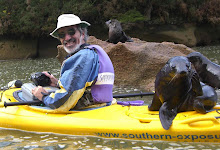Earlier this week I was pretty much over my head.
We moved into an area that has to do with manipulating functions in terms of each other – adding, subtracting, multiplying and then dividing functions by functions. And on top of that, we started solving functions “in terms of” other functions.
I didn’t know what that stuff meant either only five days ago.
I struggled with the textbook and just couldn’t get past the language. I’d start reading and simply get lost. I’d see the words and numbers but they just didn’t make sense.
All of which got me thinking about my own approach to teaching.
I try to get my students to “jump in now” and start doing journalism, especially multimedia journalism. I (along with millions of 20 and unders and not a lot of over 40s) am convinced that you can’t learn Photoshop or Final Cut Pro or any complicated piece of software by watching some expert demonstrate tools on a video projector and lecture about techniques. You gotta do it with your own hands and fingers and make mistakes and try again until it gets into your muscles.
Seth tells me that’s how it works in sports. Reading might be good for motivation, but a chapter in a book is probably not going to help you two-putt as much as getting on the green for 200 strokes a day.
I think the same is true for math. Watching even a very good teacher such as Steve takes you only so far (not very). It takes reps for the ideas to begin to sink in.
I didn’t used to believe that.
Back when I cared about playing music, especially recorder or clarinet, rather than practice, I’d read books. I read about the clarinete’s history and construction. I became an expert on the different woods that a craftsman could make a recorder out of. I knew the attributes of rosewood, ebony, and boxwood. I took a course about music theory at the University of Arizona and got an “A” (one of my few). But I never got very good at either clarinet or recorder. When I should have been practicing an A minor scale or learning how to improvise by memorizing chord progressions, I was reading an article or listening to a lecture.
Photography was different. I got out in the field and took pictures. Thousands and thousands of them. And, amazingly, I got better and better. Portraits, landscapes, sunsets, still lifes. I used all kinds of formats. Large format, 2 ¼, 35mm, minox, and digital. Now I give lectures about photography to people who ought to be out shooting instead of sitting in a fancy meeting room listening to me talk about taking pictures.
Which brings me back to math.
I was saved once again by the online math program from last semester’s course through Pima Community College, mathxl.com.
The access to the program that came with last semester’s book gave me a full year's access to all the textbooks the site serves and its supporting online exercises, videos and animations.
I found an equivalent level textbook, signed on to it, and started doing my “reps.”
At first I let the program walk me through solving the problems, then I was able to do more on my own. In not too much time I was actually beginning to “get it” enough to be able to tackle this week’s homework assignments. Even the book began to get a little bit more comprehensible. For the first time in at least a couple of weeks, I’m feeling somewhat encouraged.
It felt good to look at the homework assignments in the book and reflect back only a week to where I didn’t know even how to begin to approach solving a single one. Now I’ve done them all, mostly correctly, and sorta get what’s going on.
The skills might not stick, but that’s a story for another time.

No comments:
Post a Comment